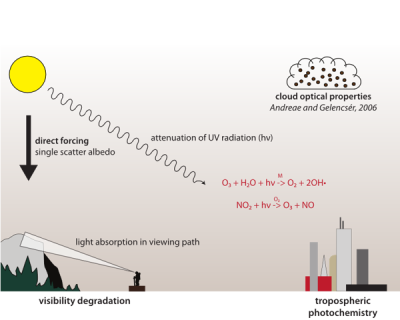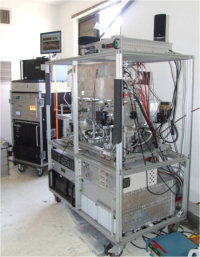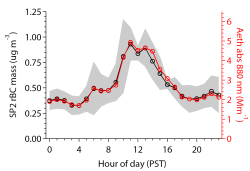Multiscale Chemical Composition of Carbonaceous particles and Coatings (MC4)

Black carbon (BC) aerosol, sometimes called "soot", absorbs visible light, so it affects the radiative balance of the atmosphere, visibility and photochemistry (Fig. 1). It warms the climate, but has a short atmospheric lifetime compared to other greenhouse gases, so may be targeted for short-term mitigation efforts. The impacts of BC on the atmosphere are determined by its lifetime, which depends on how it is mixed with other aerosol species (known as the BC mixing state). BC particles can acquire coatings that can change the BC core shape and increase or decrease the amount of light absorbed by the particle. Our understanding of how BC interacts with other material and becomes coated is relatively poor because until quite recently there was a lack of appropriate instruments needed to directly measure BC mixing state and composition.
MC4 is improving our understanding regarding BC mixing state by deploying new instruments, the single particle soot photometer (SP2; DMT Inc.) and the soot particle aerosol mass spectrometer (SP-AMS; Aerodyne Research Inc.) together with established aerosol absorption measurement methods in the laboratory and field to measure ambient and artificial BC particles. The SP-AMS differs from a traditional AMS in that the heater used to volatilise aerosol prior to ionisation has been replaced by an intracavity IR laser (identical to that in the SP2). The IR laser only vaporizes particles with an IR light absorbing core (mostly BC), but any non-BC material mixed with the BC also volatilises as the BC core heats up in the beam. The SP-AMS would not respond to a pure, non-absorbing ammonium nitrate particle passing through the laser beam, but it would detect ammonium nitrate coating a BC particle because the coating evaporates in the beam. Thus, the SP-AMS has the advantage of measuring both a) BC mass and b) mass and composition of any associated coating.
The SP-AMS is a central character in this project, but it is by no means the sole player. We are hoping to learn more about how the SP2 responds to different coatings and how both the SP2 and SP-AMS measurements compare with absorption measured by Aethalometer (filter-based) and photoacoustic (in situ) absorption instruments. The Aethalometer is a widely-used technique in which the absorption by particles is determined from the measured attenuation of light through a loaded filter. The photoacoustic method relies on measuring the pressure perturbation (i.e., sound wave) produced by particles when they absorb light and heat up slightly. The SP2, SP-AMS and Photoacoustic methods avoid some of the complications resulting from using a filter to sample particles, such as interference from non-absorbing particles co-sampled with the absorbing ones. Part of our objectives in MC4 is to explore the relationships between BC mass, mixing state, and absorption properties measured by the photoacoustic and Aethalometer techniques. The other main MC4 study objectives are to:
- Quantitatively differentiate the measured compositions and optical properties of BC particles according to source and the level of atmospheric processing and derive parametrisations suitable for radiative and chemical transport models.
- Quantify the core masses, coating compositions, mixing states and mass specific absorption of BC particles encountered in a range of atmospheric conditions.
- Characterise the SP-AMS detection limit and response to coated and uncoated BC particles of a variety of compositions and sizes under controlled laboratory conditions.
- Develop the SP-AMS hardware and operational procedures so as to maximise instrument sensitivity, accuracy and quality assurance.

As of January 2011 the SP-AMS, SP2 and absorption instruments have been deployed in two field campaigns: at the Cal-NEx Pasadena site near Los Angeles, California during the summer of 2010 (Fig 2.) and at the SP2 intercomparison project at the AIDA (Aerosol Interaction and Dynamics in the Atmosphere) chamber in Karlsruhe, Germany in Autumn 2010. Early results from the Cal-NEx measurements are available in a presentation here. We've also developed a new application combining the SP2 with a humidified tandem differential mobility analyser (HT-DMA) to measure BC hygroscopicity as part of MC4 in a manuscript that has been recently submitted to Atmospheric Chemistry and Physics (link to be available soon). Future deployments are scheduled for eastern England at the University of East Anglia's Weybourne Atmospheric Observatory and in central London for the ClearfLo (Clean Air for London) project in 2011.
MC4 results
We measured BC mass concentrations and mixing state for approximately 4 weeks in the Los Angeles basin during CalNEx, between 15 May to 15 June 2010. Most of the measurement period featured overcast conditions and relatively low pollution loadings, though there was a period of clear skies and elevated pollution levels in early June. BC mass concentrations measured by the Aethalometer absorption-based instrument, the SP2 and the SP-AMS were all higher during this period compared to earlier in the campaign (Fig 3). We still need to process and analyse the SP2 data (the single particle instruments generates LOADS of data), but based on the good agreement we observed between it and the Aethalometer during the period for which we have analysed data we aren't expecting any major surprises for the rest of the dataset. One early surprise was that the relationship between the SP-AMS BC signal and the other BC measures showed a strong dependence on the contribution of nitrate to total mass associated with the BC particles.

There was a strong daily pattern in BC mass concentrations during the CalNEx measurement period (Fig. 4), with peaks associated with early morning traffic between 0400-0800 local time and a more dominant noon peak associated with transport and mixing in the Los Angeles basin. Weekends saw a very different daily pattern, with almost no increase in BC loadings during the day. Many previous studies in urban areas including LA have shown a reduction in lorry and other heavy duty vehicle use on weekends. The strong weekend effect observed in LA is consistent with lorries and other heavy duty (diesel) vehicles being the primary fresh BC source. We also observed the some of the smallest BC mass distributions we have observed with the SP2 in our five years of performing measurements with the instrument, as did the NOAA SP2 group in their airborne measurements over the basin.

MC4 publications
- McMeeking, G. R., N. Good., M. D. Petters, G. McFiggans and H. Coe, Influences on the fraction of hygroscopic and hydrophilic black carbon in the atmosphere, submitted to Atmospheric Chemistry and Physics.
MC4 presentations (talks and posters)
- Ambient measurements of black carbon using the new SP-AMS in conjunction with other instruments, American Geophysical Union Annual Meeting, San Francisco, USA, Dec. 2011. (pptx)